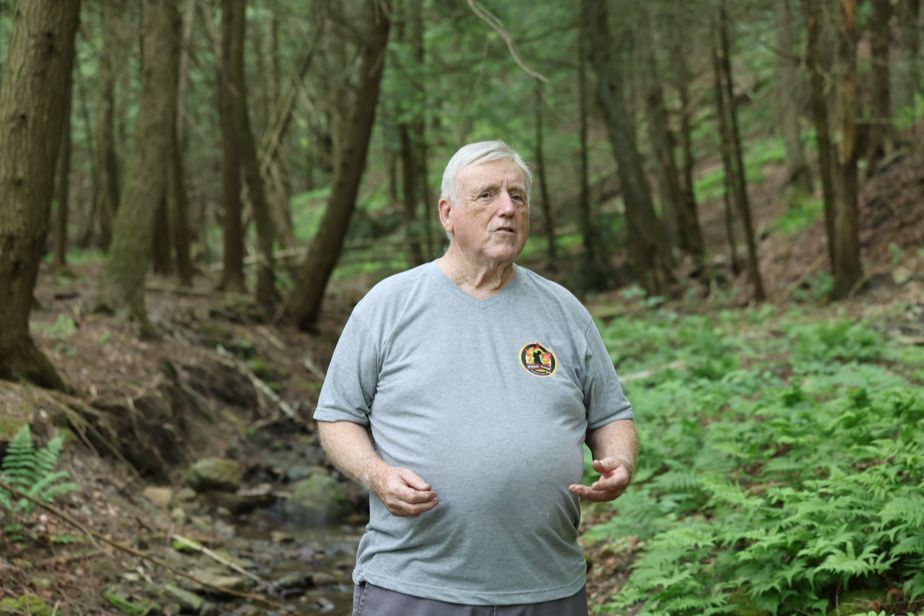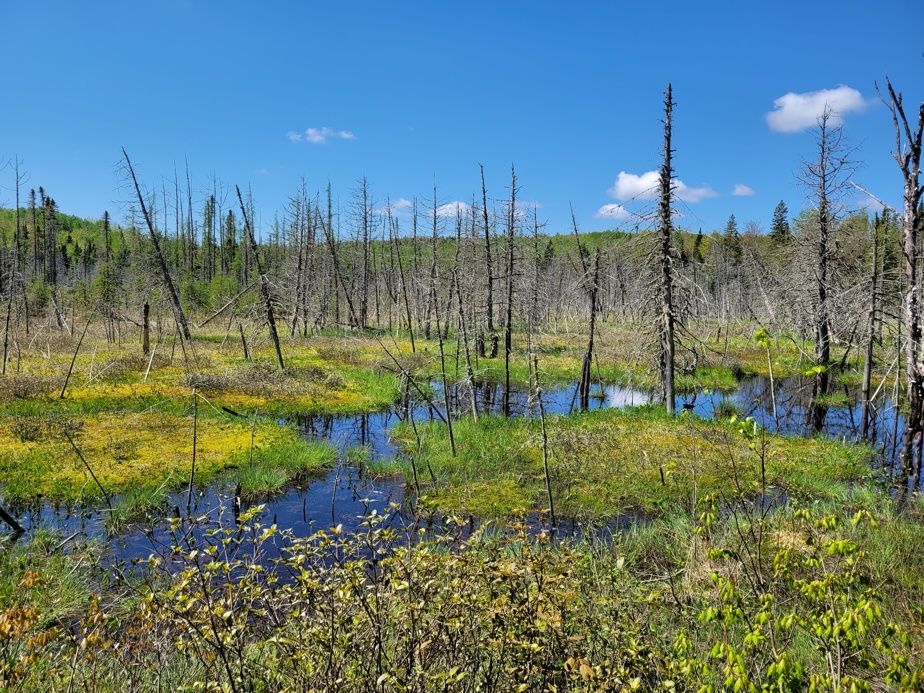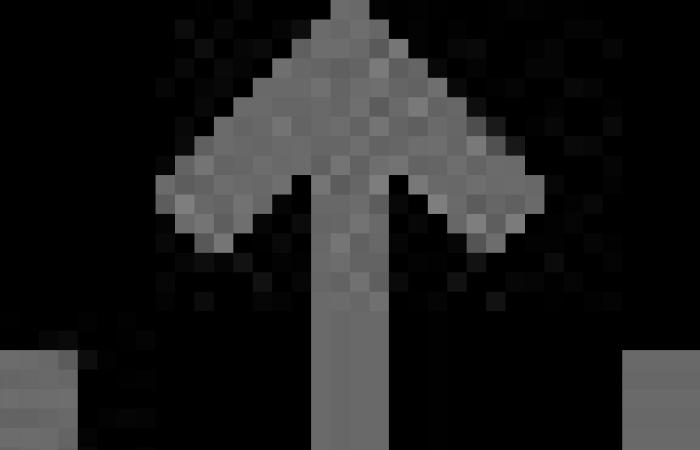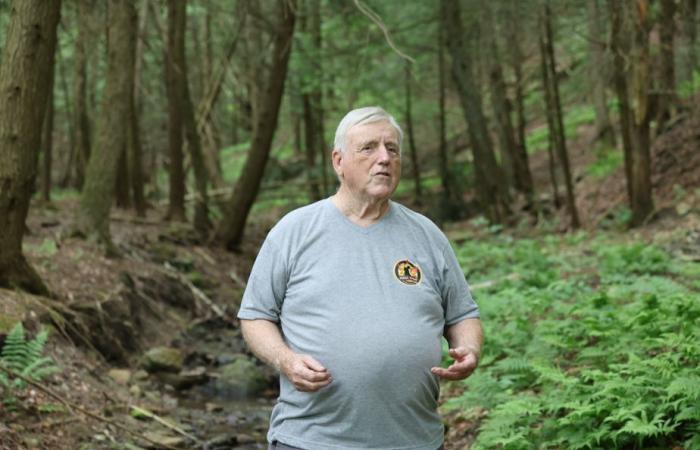“A little higher up there, up the creek, there are blackberries. This is a black bear’s paradise. There’s spring water. This is their home; we’re the invaders, not the animals, not nature,” says Arnold Raymond, pointing out the fresh tracks of a black bear at our feet.
Published at 1:52 a.m.
Updated at 8:00 a.m.
The old man spent 45 years of his life on this land located on the southern slope of the Sutton Mountains, in Estrie, in the corridor of what we call the Green Mountains. He decided to leave a large part of it so that it would remain in the wild in perpetuity. Thus, 34 hectares of its territory – the equivalent of 214 National Hockey League ice rinks – were donated to the Nature Conservancy of Canada (NCC). The protection offered by the organization means that it will forever be prohibited to hunt or camp in this area, or even to make it a park or a vacation spot.
PHOTO MARTIN CHAMBERLAND, THE PRESS
The land is crossed by a stream.
Covered largely by forest, the now protected territory is home to a rare species of bird, the eastern wood-pewee (Contopus is green). In its stream swims the purple salamander, designated vulnerable according to the Threatened or Vulnerable Species Act from Quebec. Over the years, Mr. Raymond has encountered lynx and deer. He even believes he has seen a cougar. But it was with black bears in mind that he chose to bequeath this land in the name of his in-laws, Hugh and Dorothy Sherrer, who had purchased it in 1949.

PHOTO MARTIN CHAMBERLAND, THE PRESS
Arnold Raymond
I believe there is a family of five bears living nearby. I want to make sure they keep their home.
Arnold Raymond
In Quebec, no fewer than 70 organizations or trusts accept “ecological gifts” from individuals, industries and municipalities. In Mr. Raymond’s case, it was his real estate agent who helped him with the process when he sold his in-laws’ former farm. A team accompanied by a biologist first went to the site to assess the value of the ecosystem. CNC financed Mr. Raymond’s efforts, from the ecological inventory to the survey, including the location certificate and property assessment, all the way to the notary’s office.
In exchange for the land, donors receive a charitable donation receipt that qualifies for a tax credit.
PHOTO MARTIN CHAMBERLAND, THE PRESS
Mr. Raymond made this “ecological gift” to the Nature Conservancy of Canada.
Caroline Petit is a project manager at CNC. She explains that the organization’s mission is to be the watchdog of ecological legacies. A network of volunteers crisscrosses the protected lands, in particular to ensure that there are no invasive species. The organization is funded by the provincial and federal governments, as well as donors. Beyond the conservation of natural environments, CNC has a research and education mandate.
“It is thanks to people like Mr. Raymond that we can accelerate nature conservation and have an impact on biodiversity. Land is increasingly expensive, acquisition is a major challenge even with government support. It is therefore thanks to land donations that we hope to achieve our conservation objectives by 2030 and change things,” explains Mme Petit.
In Quebec, 76,815 hectares on 1,587 so-called “voluntary” conservation sites are protected, according to the Réseau de milieux naturels protégées. A new map is currently being updated. Across Canada, between 1995 and 2016, nearly 1,300 ecological gifts were counted by the federal government, especially in Quebec and the Prairies.
Lanaudière Donations
The director of the organization, Brice Caillé, believes that the number of donations may seem high, but that it is not enough. “A lot of land has been lost. We still see it these days for Rabaska, in Lévis, where there are industrial projects despite the purchase of one of the lands by the government. Municipalities must have more duties and legal powers for ecological protection,” he believes.

PHOTO PROVIDED BY FICEL
Some 22 hectares of mountainous territory were recently bequeathed to the Lanaudière Ecosystem Conservation Trust (FiCEL). The land has many wetlands.
On June 6, in Sainte-Émélie-de-l’Énergie, the Lanaudière Ecosystem Conservation Trust (FiCEL) celebrated the largest land donation to date in this region: 22 hectares. The donation comes from a citizen of Montreal, Linda Reven. It had acquired the mountainous territory, with numerous wetlands, but devastated by clearcutting., 22 years ago. The organization protects, conserves and develops 645 hectares in 20 areas, from Mascouche to Saint-Zénon, further north.
300
Number of animal species recorded on the protected lands of the Lanaudière Ecosystem Conservation Trust, or 35% of the 844 species listed in Quebec.
Source : FiCEL
Biologist and FiCEL leader Marie-Pierre Thibeault explains that a vast inventory of insects and bats will be carried out this summer on their land, including several wetlands. From 2018 to 2023, nearly 80 species of birds have been counted, including the Canada warbler (Cardellina canadensis) and the wood thrush (Hylocichla mustela), fragile species under the Endangered Species Act.
PHOTO PROVIDED BY LA FICEL
Donor Linda Reven, surrounded by Martin Héroux, mayor of Sainte-Émélie-de-l’Énergie, and Marie-Pierre Thibeault and Marie-Josée Berteau, respectively general director and deputy general director of the trust
“There is no development or logging on our land,” recalls M.me Thibeault: Our mission is to protect them, we carry out biological monitoring. And we have volunteers who act as guardian angels, in particular to prevent illegal dumping of waste or other activities that endanger ecosystems.
Discover Canada’s Ecological Gifts Program
Consult the Directory of voluntary conservation sites in Quebec
Visit the CNC website
Visit the FiCEL website









